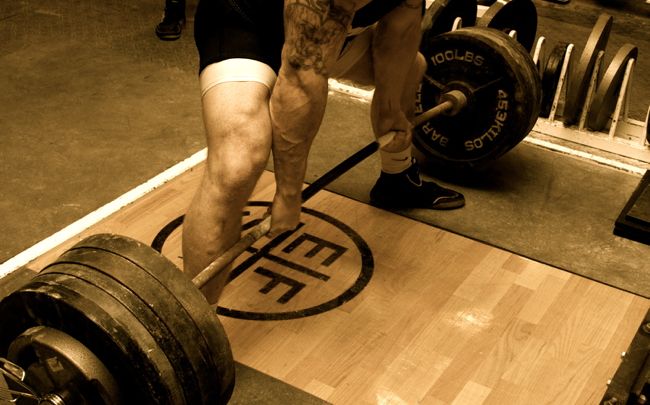
I would like to share with you a movement that has been extremely beneficial to my athletes. This movement builds starting strength, acceleration strength, limit strength, explosive strength, relative strength and rate of force development. I'm going to explain how it works in simple, layman’s terms. This is not merely a theory I think will work, it is a movement that has worked time and time again. This keeps in the spirit of finding out what works, then finding out why later. No Harvard studies to back this bad boy, just multiple PR’s by my lifters. The movement I'm talking about is the dead squat.
From a pure raw lifting stand point, this movement is very beneficial to those who have a sticking point in the squat a few inches above parallel and to sumo deadlifters, but it will also benefit the conventional deadlifter.
Since the dead squat is performed off the pins (bottom up style) there is no eccentric phase of the lift, no elastic energy assists you on the concentric phase of the squat. You are lifting dead weight, like a deadlift. Plain and simple, you live or die on this lift based off your starting strength.
One way to take it a step further, is to use bands and chains in order to build acceleration strength. Both of these tools will increase tension as the weight is lifted off the pins, so the resistance is heaviest at the top, where most people are the strongest. This type of training complements the strength curve of the lift, which allows for limit strength and acceleration strength to be built. If the athlete doesn't lift the weight fast enough, he won't successfully complete the lift because the tension is increasing. This effectively bypasses the negative acceleration phase that takes place in the top half of the lift. The one draw back to compensatory acceleration training (CAT) is that it means lifting sub maximal weights with maximal force.
Dead squats develop rate of force development (RFD), which is how quickly one can develop tension in a muscle. Concentric-only muscle actions, with no negative loading phase, offer huge gains in RFD. There isn't a stretch shortening cycle to help you, so you must develop tension in the muscle quickly if you're going to get it moving.
Relative strength is effectively your bodyweight to strength ratio. One can gain strength by an increase in muscle size or neural adaptations. Concentric-only muscle actions, like the dead squat, are associated with increased neural efficiency, and are an inferior method for muscle hypertrophy. This means that if your goal is size alone, this is not the movement for you. If you need to remain in a certain weight class, this is an excellent choice.
The dead squat should be performed for singles. For higher volume and lower intensity, use multiple singles followed by short rest intervals. Proper progression is where many people fail in their strength programs. We can know science in and out, but if we don’t understand the true art of progression, we will not progress. Learning proper progression is done in the trenches. Some variables to increase intensity on the dead squat are shortening rest intervals between singles, adding more singles to the same weight, adding more weight, or adding bands or chains. You can also look at lengthening rest periods and decreasing the number of singles as the weight gets heavier. Looking only at bar weight is a good prescription to running yourself into the ground quickly.
Week one might be eight singles with a 45 second break, and then week seven might be three singles with a full recovery. Obviously, the weight has increased and the perceived rate of exertion may be the same both weeks. If you want to build limit strength, starting strength, and overall power, give dead squats a try.
Some Key Points to remember are:
- Squats are a reversible muscle action with a stretch shortening cycle (SSC), excessive abuse of this exercise could potentially retard the SSC. This is a supplementary exercise, not a replacement.
- This lift will benefit the deadlift and generally offers a higher degree of dynamic correspondence (transfer of training) to sumo deadlifts but will benefit the conventional puller. Remember, if you are trying to increase your sumo pull, use the same stance and start at similar hip and knee joint angles. If you sumo deadlift from a half squat, starting the dead squat in a full squat or quarter squat position won't offer the same benefit as starting from the half squat position.
- Perform this exercise with straight bar weight and with bands and chains.
- If your primary goal is muscle hypertrophy, this exercise doesn't have a real big benefit in your program.
- Dead squats are very beneficial to those that have a sticking point two to three inches out of the hole in the squat.
Check out this video of Big Ed McKelvey doing Dead Squats








